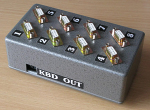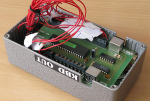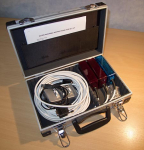Mark Buckley-Sharp CEng FBCS CITP
Design of a Scoring Machine (Multi-Judge Scoring of Photographic Competitions)
Summary: There is a requirement for recording and totalling the scores from multiple judges in many federation, national and international photographic competitions. To meet this requirement there have been several designs of hardware made by various organisations in the past. As these age, their maintenance has become either difficult or impossible, and there is a need for an available design which can be simply made. My design replaces all the bespoke hardware by readily available standard components, and transfers the functional complexity to software which can be run on any standard computer system.
The hardware design and all versions of the software are copyright. They are licenced for free use by the Photographic Alliance of Great Britain, its member Federations, and its affiliated Clubs.
Hardware
There are two designs for the hardware.
The hand-made design uses readily available components but requires relevant skill to assemble them into the complete system. Three copies of this design have been made. The original prototype demonstrated the concept by allowing up to eight judging handsets to be connected. Two copies of a simplified 3-judge system followed. Download the Design Specification (pdf). Images of both types are in the gallery. The original supplier of components for this design (Maplin) is no longer in business: making another copy of this design would require an alternative source.
The off-the-shelf design uses readily available parts (eg, Amazon) and requires no specific skill in assembly. The handsets are programmable keyboards and they are connected using USB cables and hubs. Download the Design Specification (pdf), which includes information on how to reprogram the handsets. Download handset labels. Images are in the gallery. While the basic use of this design would be for three judges, extension to six or even eight judges merely requires additional parts of the same types.
A different standard ASCII character is sent for each button pressed on each judge’s handset. The character may be decoded into judge and score by any suitable software.
Software
Software was originally developed in VBA for MS-Access. For wider applicability, this was recreated and further developed to use VBA in MS-Excel. (Current version ref: E309, March 2023)
- Download the Features Description (pdf).
- Download the Instruction Manual (pdf).
- The software is a macro-enabled Excel workbook. Read the manual in full, including the security information, before deciding whether to download the software.
- Download the software (zip) to your default download folder. Extract the zip file to obtain the Excel97-03 xls file. If Windows is blocking one or more files, see HERE.
Gallery pictures of the Scoring Machine hardware.
How does this design differ from some other current designs?
A Design for Western Counties Photographic Federation uses handsets where each has its own keyboard encoder with USB lead. By wiring each handset uniquely, three handsets can be connected through one USB hub. Each key gives a unique character (by score by judge) and the same software decoding method is used as for the handsets shown here. The programmable keyboards shown in the gallery are effectively the same.
Commercially available USB numeric keypads can be connected through one USB hub. The judges must limit themselves to the valid numeric scoring keys, depending on the competition format. Two methods have then been used to identify the judge for each score.
- The USB address of each keypad is identified by a specific software module, which must be installed and integrated with scoring software. This method has been used with the PhotoComp scoring system (Philip Stapleton), and with the ImageCompPro scoring system (Roy Moore, up to version 18 only).
- Five non-numeric keys ( / * – + . ) are available to be assigned each to one judge, and the judge prefixes the numeric score by their own identifier. This method has been used by the Ivybridge scoring system (Derek Rayner).





